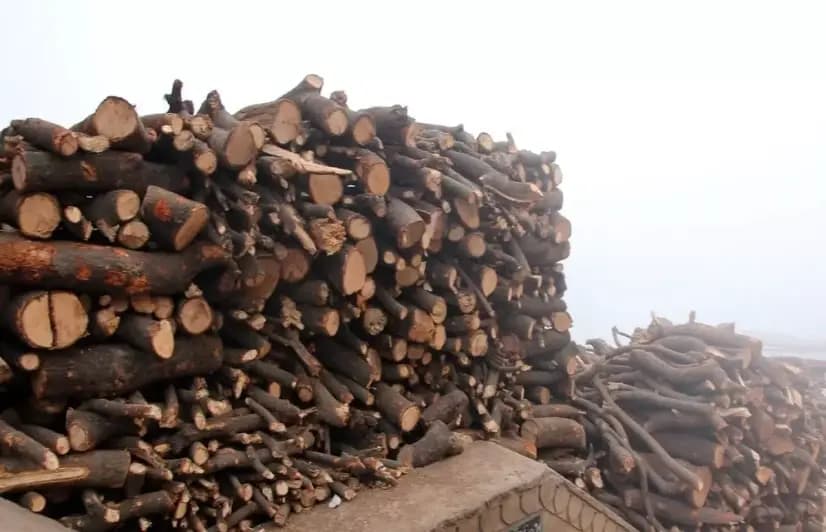Demand for wood in crematoriums causes widespread tree felling in Uttarakhand
Villagers have been forced to chop down trees due to the absence of adequate wood storage facilities in many of the Himalayan state's crematoriums.Almora: In January this year, 50-year-old Govind Gopal, an environmental activist from Danya — a small tourist stopover between Almora and Pithoragarh in Uttarakhand — went on a hunger strike to raise concerns about and demand accountability for the rampant felling of trees for cremations. He called for a green cremation facility at the local crematorium and the establishment of wood storage facilities in crematoriums where it's not available. Given the cost of wood and the absence of wood storage facilities in most of the state's crematoriums, the villagers of Uttarakhand have been forced to fell trees. While poor villagers prefer to chop trees for wood rather than buying them to save money, a lot of people would start buying wood if it was available at village crematoriums. People also sometimes opt to bring their own wood for cremation, because what is available in crematoriums is often 'inferior', containing tree roots, branches, etc which don't burn properly.Officially, wood for crematoriums is supplied through designated government forest depots. It is sourced from only dead trees or those uprooted due to storms or other natural causes. After measuring and collecting the wood, Uttarakhand Forest Development Corporation (UAFDC) transports it to the depots that are called tals — from where relatives of the deceased can buy wood for cremation. However, some environmental activists, on the condition of anonymity, claimed that crematoriums also source the wood from vendors who might be deriving the wood through 'illegal' means.There are approximately more than 10,000 unregistered crematoriums across Uttarakhand, mainly along the banks of over two dozen rivers, crisscrossing the mountainous state. However, only a hundred-odd crematoriums, have a tal at the facility. UAFDC stated that they supplied 19019.16 cubic meters of fuelwood to tals in May this year, during the peak of the pandemic's second wave, compared to 875.26 cubic meters a month earlier — a 22 times increase, approximately. There is no data on the consumption of wood in unregistered crematoriums or those without tals during this time.Cremations underway at the Areshwar crematorium in Almore. It doesn't have a tal and people have to bring their own firewood (Picture credit: Shankar Dutt Bhatt)The high cost of dyingIn Almora district of Uttarakhand's Kumaon division, Areshwar ghat is one of the many crematoriums catering to the 151 villages of the Dhauladevi block. Situated on the banks of the Saryu river, it doesn't have a tal. There are only 11 tals catering to Almora's over six lakh population. 'Wood is usually brought from villages, but sometimes people also fell trees for cremation,' said Shankar Dutt Bhatt, a resident of Danya town in the Dhauladevi block.Villagers usually cut down trees while on their way to the funeral, preferably at a place near the crematoriums to save transportation costs. Bhatt revealed that even the forest guards overlook the activity due to the ‘emotions’ involved in the process.Rameshwar ghat, situated at the tri-junction of Champawat, Almora, and Pithoragarh districts, has a tal. However, despite the availability of wood at the crematorium — which receives about half a dozen bodies every day — people still prefer to bring wood from the trees, which they felled along the way. 'In crematoriums that have the facility of wood storage, an assortment of wood is provided that includes roots of trees that don't burn easily. Thus a large quantity of wood needs to be purchased to facilitate the burning,' explained Bhatt.A quintal of wood at Rameshwar ghat costs around Rs 400. Almost seven to eight quintals of wood are consumed in a pyre. Apart from that, there are overhead charges such as those of transportation, shroud, services of priests, etc., which makes the whole process expensive for poorer people. Usually, pine is the preferred tree for cremation as its wood burns quickly. "It takes around two hours to fell a medium-sized pine tree," said Bhuwan Chaubey from Bageshwar district. Sometimes tyres are also utilised to cremate a body, particularly during the rainy season — notwithstanding the amount of air pollution its combustion generates. The green way to goBe it tyres or trees, cremations can be highly degrading to the environment. Anshul Garg, co-founder and president of Mokshda, a Delhi-based NGO working to reduce the environmental impact of funeral pyres, said that the felling of trees for cremation is not limited to Uttarakhand. Around sixty million trees are burned every year in funeral pyres across India. "A tree takes 15-20 years to grow, and we take a few minutes to fell it and burn it in funeral pyres," Garg said, explaining that replanting can't compensate for trees felled for this purpose.Garg's organisation has been propagating ‘green cremation’ for the last three decades and has developed a cremation system that uses one-third of the wood that a typical cremation requires. In this system, the body is placed on a metal grate rather than directly on wood, as is the case with traditional cremation. This ensures that the circulation of oxygen is not blocked and the combustion is efficient. The metal grate gets heated by the wood underneath it, which enables better air circulation around the flames. A chimney also traps much of the particle matter produced and releases clean emissions.'Not only does the system reduce tree felling but also decreases the number of pollutants that go into the air and water due to cremation,' Garg said. Moreover, the system allows people to perform all the traditional rituals involved in a Hindu cremation, some of which might not be possible at electric or CNG-run crematoriums. Similarly, some students and alumni of the Indian Institute of Technology, Delhi have been promoting a system that creates logs out of cow dung to replace wood in funeral pyres.These 'green cremation systems', got a fillip during the pandemic as relatives of the deceased seemed less resistant towards cremating bodies in alternative ways. However, the environmentalists feel that a long-term strategy needs to be chalked out to promote them better, starting with designating a group of people at the crematoriums to educate the people about the benefits of the green cremations.

Dalit entrepreneurs help bridge digital divide during pandemic
A Delhi-based organisation is equipping the members of the Scheduled Castes with digital literacy to help them thrive in the gloomy economic scenario.Ashok Bharti, chairperson of the Dalit-Adivasi collective National Confederation of Dalit Organisations (NACDOR), told 101Reporters they have enabled about 290 small-time entrepreneurs from socially disadvantaged groups gain employment in the past few months. He added that though India is struggling through a pandemic, these entrepreneurs have cumulatively earned over Rs 5 crore in the first five months of the lockdown period. Bharti underlined that the aim of their programme, being run in collaboration with Tata Consultancy Services, is to bridge the digital divide between the rural and urban India.“The task was to impart functional literacy of computers among the educated youth [belonging to socially disadvantaged groups], who could then be incentivised into teaching,” he said.Meera Ahirwar, 25, a resident of Gor Gai village in Madhya Pradesh’s Chhatarpur district, was given training in digital skills. In return, she has to impart the skills to the students of her village government school. She'd be given a stipend for this. With a postgraduate degree in Geography and a Bachelor’s degree in education, she would find it difficult to secure a job as she belonged to the Dalit community. She would even have to face casteist taunts en route to the local school she taught at. She quickly learned to execute various digital tasks like online banking, utility bill payment and extending benefits of various government schemes through the internet. This enabled her to set up her own kiosk in 2019. Now, she helps people make transactions, apply for scholarships and other schemes.During the pandemic, when banking facilities were hampered because of the lockdown, Ahirwar’s kiosk attracted people from even far off villages. “Migrant workers who were stuck in different parts of the country during the lockdown were able to transfer money to their family members in the villages through e-payment,” she told 101Reporters. She said she also helped people procure e-passes, which were necessary for inter-city or interstate movement during the lockdown. Even the upper-caste villagers who used to mock her and not avail of her kiosk would now seek her help as all the other internet access points near the village were closed owing to the lockdown.“Initially, they would make sure that they would maintain as much distance as possible while interacting with us in our shop, but gradually the distance blurred,” underlined Ahirwar.The increased transactions during the lockdown period bumped up earning of many entrepreneurs, and it has helped them expand their business.Lifeline for villagesUjwal Mondal, 31, a resident of West Bengal’s North 24 Parganas district, earned Rs 80,000 to Rs 1 lakh each month from his three shops in Hingalganj block during the lockdown. He recently received a tender from the state government to register the people eligible for Samajik Suraksha Yojna, a scheme that provides provident fund to the workers in the unorganised sector.“I have to go to each house in the village and find out the people who are eligible for the scheme. After that I register their names online by filling a form,” stated Mondal, adding that about 75 people visit his kiosks every day.Mondal mentioned that people visit him to make changes in their Aadhaar cards and seek help in obtaining different certificates like for caste or marriage. Previously, people would have to get it through the village authorities but now they download the forms, get them filled, sign and upload them. There are 21 such entrepreneurs from the three clusters in North 24 Paraganas district. One of the cluster leaders Subarna Mondal mentioned that though their business was affected at the start of the lockdown, it picked up within 15-20 days when people realised the potential of online transactions. “People who had never done an online transaction in their lives came looking for us to withdraw cash from their accounts,” she added.In addition, Mondal said the entrepreneurs also helped fill up forms of the people who were entitled to cash support under various central and state government assistance programs. When the money for Ujjwala Yojna, PM Kisan Yojana and several other state government schemes, including financial assistance for the Amphan Cyclone, came into the account of the beneficiaries, they came to our kiosks to withdraw the money, she added. Interventions such as the digital literacy drive have come as a relief not only for the ones receiving the training but also for the society they live in, connecting many with the world wide web.

‘Gold Rush’ To Harvest ‘Himalayan Viagra’ Leaves Alpine Meadows Degraded In India’s Northern State
The mad rush to harvest expensive caterpillar fungus in the higher Himalayan region of Uttarakhand is taking a toll on the fragile ecosystem of the alpine meadows, which is the habitat of the fungus.Researchers studying the harvest and trade aspects of the Cordyceps fungus (Ophiocordyceps sinensis) say the high market price of the species in China coupled with limited manpower of the state’s forest department have resulted in the uncontrolled collection of the species causing soil cover destruction, felling of alpine trees for fuelwood and hunting of endangered animals for food by the harvesters.Cordyceps is considered to have a range of medicinal values in the treatment of erectile dysfunction, as an energy booster, and for lung, liver and kidney problems in the traditional Tibetan and Chinese medicines. Every year between May and July, thousands of villagers in the state embark on an arduous journey to the higher reaches with their domesticated animals, tents and sacks of supplies and stay for two months to harvest it. A scientist with the Wildlife Institute of India Amit Kumar, who has carried out research on the fungus species at Nanda Devi National Park near Joshimath, informed that the harvesters sometimes kill wild animals, including endangered ones such as blue sheep and musk deer, for food during their stay in the meadows.Amit explained that during the course of his research when he interacted and worked with the locals who went to harvest the fungus, he found out that it’s difficult for the harvesters to survive on potatoes and wheat and thus, they hunt wild animals for meat. The alpine meadows are home to numerous rare species like snow leopard, Himalayan blue sheep (bharal), Aconite (Aconitum heterophyllum), Brahmakamal (Saussurea obvallata) and Costus (Saussurea costus).Dehradun-based environmental researcher Subhajit Saha revealed that the villagers carry firearms with them to the meadows to hunt wild animals like blue sheep, rabbits and red foxes for their meat.He added that hunting of wild animals is not allowed anywhere in India and only the animals that have been declared as vermins can be hunted only after getting permission from the state forest department. Bharal, which is an endangered species and comes under the Wildlife Protection Act, 1972, continues to be hunted, he stated. While the officials with the forest department have strong suspicion that the villagers during their stay at the meadows hunt wild animals, the lack of evidence prevents them from taking further action.A forest department official from Pithoragarh, on the condition of anonymity, told 101Reporters that while hunting cases against villagers are rare, it’s common knowledge that during their stay, they not only hunt wild animals for food but also poach them as they are well-versed with the terrain.Topsoil affectedCordyceps is an entomopathogenic fungus (a fungus that grows on insects) which seeks shelter in the larva of ghost moths (Family Hepialidae). It germinates inside the caterpillar, kills and mummifies it.“The fungus attacks the larva under the soil and eventually a stalk-like body of the fungus emerges out of the caterpillar body. Harvesters crawl on the surface and dig [the] soil to collect the fungus,” says Dr Subrat Sharma, a scientist with the G.B. Pant National Institute of Himalayan Environment & Sustainable Development.Environmental researcher Saha revealed that the alpine meadows are mostly rocky and have a thin layer of soil that takes hundreds of years to form. He added that the harvesters dig up the soil to collect the fungus damaging the surface layer of the area.The demand for the fungus reportedly shot up in 1993 when three Chinese athletes broke five world records at the Beijing National Games after regularly consuming a tonic apparently made from the fungus.The fungus, locally known as Kira Jari, was introduced to the locals in Uttarakhand by migrant Nepalese labourers. It is known as Yartsagunbu in Tibet and Yarsagumba in Nepal. Harvesting of the fungus began in around Askot region in 1996–1997 from where the practice gradually spread into different valleys. Today, most of the households in and around the Nanda Devi Biosphere Reserve and Askot area rely on the caterpillar fungus for their livelihoods.Harvest of the fungus has transformed the lives of the people bringing in a much-needed economic boost to the villagers of these far-flung areas who have traditionally been reliant on herding and subsistence agriculture.There is a well-established network of local middlemen, brokers and merchants in the border townships of Dharchula and Munsiyari in Uttarakhand. The proximity to the porous border with Nepal and Tibet makes it easier for traffickers.A local seller usually fetches around $20,000 (over Rs 14 lakh) for a kilogramme of Cordyceps (a family of four harvests on average weighs around 150 gram during the season) making it a lucrative business for the villagers.Decline in numbersIn the last ten years, researchers say, harvesting has become more intense causing a decline in the yield. Dwindling collection of the fungus has made the harvesters prolong their stay in the meadows for a better chance of finding the elusive species. The fungus is found in the alpine meadows between 3500 and 5000 metres above mean sea level.A portion of the land where these fungi grow fall under the van panchayat (village council) land and has been distributed amicably between the residents of the villages. Saha highlighted that the harvesters cross over to protected lands of national parks and wildlife sanctuaries regularly in their quest for the fungus.“Prior permission is required to extract wildlife resources from restricted areas. However, the caterpillar fungus harvesters often harvest in these areas because of the unavailability of forest staff to monitor their activities,” stated Saha.Higher anthropogenic pressure in the meadows in the form of an increased number of harvesters and the number of days they spend in search of the fungus also leads to the dumping of non-biodegradable waste like plastic bottles on the surface and open defecation contaminating water sources of the landscape.“Thousands of villagers go for mass-collection of the species each year, along with their tents, food, other consumables and domestic animals. These huge aggregations in the remote pastures are bound to destroy the pristine nature of the ecosystems and the threatened species that inhabit them,” Pramod Kumar Yadav, a researcher who has carried out research projects on the fungus, told 101Reporters.

Write For 101Reporters
Follow Us On
101 Stories Around The Web
Explore All News